Nintendo: Success Is in the Cards
1889 is a very important year in videogame history. Yes, that’s 1889. It is this year when Fusajiro Yamauchi founds Nintendo (任天堂) Koppai on September 23 in Kyoto, Japan. To attempt a translation of the name: nin(任) translates to “entrust to” or “heavy responsibility”, ten(天) equates to “heaven”, and dou(堂) translates to meaning a shrine or other such building or hall of importance. Put together, it roughly translates to a statement that while they will work hard, this is a company whose fortunes are to be left to the mercies of heaven.
The company’s products are carefully hand-crafted hanafuda playing cards, made from the bark of mulberry trees. The term “hanafuda” means “flower cards”, named for the depiction of flowers found on them, which changes depending on the region they’re sold in. Hanafuda games constitute a popular pastime in Japan, and Yamauchi’s cards are adopted by the Yakuza, the Japanese Mafia, as their cards of choice when gambling. Their penchant for fresh cards every hand keeps demand high. After expanding into Western style playing cards in 1907, the company becomes the largest playing card manufacturer in Japan. In 1933 they move into a proper HQ and become Yamauchi Nintendo & Company. Under the auspices of third president, Hiroshi Yamauchi, the company becomes Nintendo Karuta (Playing Cards) in 1951. A breakthrough comes in 1959 with a contract with Walt Disney Co. to produce cards featuring the world-famous Disney cartoon characters, with the series going on to sell 600,000 packs that year. By the 80’s, Nintendo will be manufacturing 80 percent of the playing cards made in Japan.
Heading into the 60’s, Yamauchi renames the company again, to Nintendo Co, Ltd., signalling his desire to expand the company’s focus from simply being a producer of playing cards. Along with numerous diversions such as a taxi company and a chain of “love” hotels that rent rooms by the hour, Yamauchi creates a division within the company that will drive it in a new direction. Headed by accounting manager Hiroshi Imanishi, the department has a simple name that belies what Yamauchi feels is the future of Nintendo: Games. Yamauchi will soon find exactly the right man to help lead this department and drive the modernization of the company, right under his nose.
Gunpei Yokoi of Nintendo: The Toy Man
Gunpei Yokoi is hired as an electrical engineer at Nintendo in 1965, to maintain the electrical equipment that keeps Nintendo’s playing card production machines running. A known tinkerer of home-made devices and gadgets, Yokoi uses company tools and material in order to craft playful toy distractions on the side. Yamauchi, touring the factory floor one day, spots one of Yokoi’s creations. It is a mechanical arm made from wooden lattice, which stretches out several times its length when the handles on one end are pushed together, along with grippers at the other end that close, allowing the user to grab things from a distance.
This penchant for utilizing older technology in new ways instead of always chasing the latest thing forms the core of Yokoi’s design philosophy. It is an attitude that eventually filters down into the very marrow of Nintendo, where developed technology often shows up in practical use even 20 years after the fact.
The maintenance man is told to bring both the toy arm and himself to the Chairman’s office. Rather than the reprimand Yokoi is expecting for goofing off on company time, he is instead told to refine his toy into a product Nintendo can sell. When the device is released to market as the Ultra Hand in 1967, the toy is a big hit, selling 1.4 million units. Yokoi is quickly kicked upstairs by Yamauchi and put under the auspices of Imanishi as the lead in a new engineering department within Games. Yokoi’s division constitutes the first research and development (R&D) department within Nintendo. A number of these R&D teams would eventually be created, each with a different head and each competing to win the approval of Yamauchi and have their ideas moved into production. Yokoi’s original department is tasked to develop new, exciting entertainment products for the Japanese market. A line of other Ultra toys made by Gunpei follows, including an indoor pitching machine using light plastic baseballs, called Ultra Machine, as well as the toy periscope Ultra Scope. The R&D team also produces the Love Tester in 1968, Nintendo’s first foray into the use of electronics, where two people would each hold a sensor attached to a small handheld meter, and then hold hands to complete the circuit. The meter would then display their “love score”. This unusual device is a big hit in Japan, most likely due to being purchased as a reason for young men and women to hold hands in a culture where this is still a risqué thing to do.
JUMP: Japanese commercial for the Love Tester
Lighting it Up
After meeting a representative from Sharp named Masayuki Uemura who is trying to interest Nintendo in finding uses for Sharp’s solar-cell technology, Yokoi develops a series of light-gun games called Kousenjuu or Ray Gun SP, selling in stores beginning in 1970. These consist of toy pistols or rifles that project a beam of light, which when aimed correctly, would be registered by Sharp solar cells inside various targets that react by falling apart or lighting up. This type of toy tech would be utilized by various other manufacturers over the years, including in the Marshal BraveStarr line by Mattel in 1986.
TV ad for Mattel’s BraveStarr, using same concept as Nintendo’s light gun toys, 1986
Gunpei lures Uemura over to Nintendo in 1971, where he eventually heads up the second Nintendo research and development department, R&D2. The Ray Gun series of toys eventually morph into a large scale version, developed in 1973 and installed in former bowling alleys left empty after the 60’s bowling craze in Japan had passed. Against a wide mural of a painted wilderness, the Laser Clay Shooting System has people paying to take shots at clay targets projected on the wall with another version of Yokoi’s light rifle, with a positive hit showing the targets exploding. The venture is another big hit for Nintendo, that is until the OPEC-driven oil crisis starting in 1973 causes a wave of belt-tightening in Japan, resulting in a rash of canceled contracts. Having expanded into multiple locations costing ¥4 to ¥4.5 million per set-up, Nintendo ends up saddled with billions of yen in debt. Only their favourable placement on the Japanese stock market and the continuing confidence of shareholders keep the company out of bankruptcy.
To further help keep the company afloat, the technology of the Laser Clay Shooting System is shrunk down to a smaller footprint for arcades, called Mini Laser Clay. It is also adapted for use as a single-player coin-operated arcade machine in 1974, as part of Nintendo’s Simulation System. In Gun Fight, players stand at a console and strap on a holster holding a mock pistol that is tethered to the unit by a cable. Installed unseen under the console are two video projectors pointed at a screen. Would-be gunslingers watch desperadoes on the screen, previously recorded on 16mm film, and when they see a flash in the eyes of the bad guys they have to draw and shoot faster than their opponent. If they succeed, the other projector kicks in and shows the enemy shot and killed. If they miss, it’s a lost life for them. The shooting game makes its Amusement Trades Exposition debut, renamed as Wild Gunman, in London, England in January of 1975. While the simulation is scaled down from the bowling alley version shooting gallery, Wild Gunman will still shoot $14,000 out of the pockets of purchasers. Though this revised version does include a hood around the screen to make the proceedings less vulnerable to being washed out by surrounding light. Also produced is Shooting Trainer, with the same mechanics and body, only players shoot rather less interesting glass bottles as targets. Both games are released in North America by SEGA of America in April of 1976, and are eventually followed by other projection games such as Sky Hawk (1976) and Test Driver (1978).
Another coin-op game of this era is EVR Race, designed by Genyo Takeda. Players gather around the machine and place bets on the outcome of either a horse or car race, depending on how the game is set up. Once all the bets are made, a video of the race is played on a TV screen. The EVR in the title refers to Electronic Video Recording, an early version of video tape, that is stored in round cartridges. Because of this new video technology, EVR Race, released in 1975, could be considered the first video game ever made by Nintendo. Its temperamental nature, however, keeps it from becoming a success for the company.
Getting Shiggy With It
Starting in 1977, Nintendo produces a line of home video game consoles featuring built-in games inspired by Atari’s PONG, called Color TV-Game. The series starts with Color TV-Game 6 and Color TV-Game 15 that year, followed by Color TV-Game Racing 112 in 1978. Designing the outer casing of this racing game is the first project for junior employee Shigeru Miyamoto. Holding a B.A. in Industrial Design from Kanazawa Municipal College of Arts and Crafts, he is hired by the company in 1977 and assigned to the Planning Department. The final entry in the series is Color TV-Game Block Kusure (Breaker) in 1979. This game, a knock-off of Atari’s arcade game hit Breakout, also has its case designed by Miyamoto.
Click the button to play the arcade version of Space Firebird, featuring graphics by Mario creator Shigeru Miyamoto
Nintendo also moves into the arcade video game arena around this time, with such entries as Computer Othello in 1978. Block Fever, a version of Color TV Game Block Kusure in coin-op form, is also released this year. Programming for this game is done by Ikegami Tsushinki Co., Ltd. While Ikegami is more well known as a pioneer in the development of portable video cameras, they also do subcontract work as arcade game programmers for various companies, including Nintendo and Sega. Other games programmed for Nintendo by Ikegami include Space Fever and Helifire, as well as Space Firebird, for which Shigeru Miyamoto designs the in-game sprites. Miyamoto also does character design work for Nintendo’s arcade game Sheriff.
1979’s Radar Scope, another Ikegami programmed game, is a knock-off of competitor Taito’s Galaxian, an interesting but derivative take on the new genre. Miyamoto works on the panel artwork for the Radar Scope cabinet, and considering its immense popularity in Japan, a large run of the game is made and sent off to America in 1980. While operators initially snap up the Japanese import, gamers are saturated with the shooter style of arcade games. Coin intake for Radar Scope quickly slacks off and sales of the cabinet slow, leaving thousands of circuit boards for the game sitting around unused.
Doing the Donkey Kong
The company’s U.S. subsidiary is Nintendo of America, founded in New York in February 1981 by Nintendo, Co., Ltd. President Hiroshi Yamauchi’s son-in-law, Minoru Arakawa. Arakawa is in a desperate position: none of the games coming down the pike from Japan are meeting with much success in America. He is pleading for the mother corporation to send along a new, hit game. Miyamoto is tasked by Yamauchi to design a video game into which unsold Radar Scope boards and cabinets can be converted. With the dire situation faced by NoA in his mind, Yamauchi instructs seasoned Nintendo veteran Gunpei Yokoi to oversee the younger designer’s work.
The game is first planned to use characters from Popeye the Sailor, with Nintendo negotiating with King Features for the rights. The hope is that a bright, cartoony feel will separate the game from the current rash of Space Invaders-type shooting games. Miyamoto and Yokoi begin formulating the idea of having Popeye appear at the bottom of the screen, separated from his love Olive Oyl by his eternal nemesis, Bluto, placed at the top. Yokoi determines the setting; the idea for the action taking place on the frame of a partially constructed building comes from his memories of a Popeye the Sailor cartoon, made in 1934. In the animated short A Dream Walking, Olive Oyl is sleepwalking and wanders aimlessly through a construction site, where hanging girders appear just in time to keep her from falling. Within this framework, Popeye could have a wide variety of obstacles put in his way that he would have to avoid in order to reunite with his kidnapped girlfriend.
The negotiations for the Popeye licensing agreement eventually stall; Nintendo won’t land the agreement with King Features Syndicate to produce an arcade game based on the character until a year later in 1982. So Miyamoto must head back to the drawing board to create original characters. For his redesign of the game, Miyamoto has in his mind the classic story of Beauty and the Beast, as well as the 1933 movie King Kong. He starts with a drawing of a rotund little man, dressed in blue overalls and a red shirt to emphasize his moving arms as he is running, as well as to match the venue of a construction site. A bulbous nose and bushy mustache are added, mainly to avoid having to detail any facial features. The character’s informal name moves through several permutations, including Mr. Video, Ossan (slightly derogatory Japanese slang for a middle-aged man, the equivalent of “Pops” in English), and simply Jumpman. The game he designs around the character is Donkey Kong, which has Shigeru’s Jumpman running to and fro across four different screens of metal girders comprising Yokoi’s high-rise construction site, avoiding various obstacles by climbing up and down ladders. Oil drums are first considered as the objects to avoid, but this is later changed to wooden barrels, the rolling animation of which is easier to draw. The oil drum art is later relegated to a static object from which fireballs erupt and chase the player, keeping them on an ever-higher trajectory as they make their way up the structure in a bid to save damsel-in-distress Pauline from the clutches of the evil gorilla Donkey Kong. When it is determined that having to climb ladders every time a player wants to avoid something is a bit bothersome, the two designers add a jump button to give another option. This action also motivates Miyamoto to add a red cap to the character, hiding the fact that due to limited memory resources, his hairs cannot be animated when jumping.
The big ape’s last name is taken from Shigeru’s movie inspiration King Kong, with the first name evolving from the marketed title for the game in Japan: Krazy Kong. The Japanese ideogram for ‘crazy’ can also mean ‘horse’, ‘ass’ or ‘donkey’, and since Ass Kong doesn’t really fly, the translation of the game to English become Donkey Kong.
Working alongside Miyamoto, the hardware is put together by Yokoi. Yukio Kaneoka is responsible for composing the small snippets of music throughout the game. Programming is handled by subcontractor Ikegami Tsushinki, Co., Ltd.. In an arcade market that consists almost solely of space-based shoot-em-ups, Donkey Kong is greeted with a response from the employees of Nintendo of America ranging from apathy to downright hostility. Just the name of the game causes a lot of consternation, with employees coming up with such colourful sobriquets for the game as ‘Donkey Dong’. Their protests for a title change are met with the response from Kyoto that it cannot be done, as copyrights and trademarks have already been filed. Head-honcho Yamauchi insists that Donkey Kong will be the game to beat in America, and so the remaining 2000 units of Radar Scope sitting unsold in the NOA warehouse are converted to the new product. Still unsure of the strangely-named game, it is put into testing in a local watering hole in Seattle called Spot Tavern. When the total is tallied the next day, Donkey Kong has pulled in $30 in quarters, which equals 120 plays over one evening. Not a bad haul for a stubborn donkey! With a perceptible dip in coin-collection levels only occurring after 20 weeks of location testing, it becomes clear to all that Yamauchi is right!
Let There Be Mario
Donkey Kong goes on to become the biggest selling arcade game of 1981, moving 65,000 units in North America alone and even stealing the thunder of Pac-Man himself. It is Nintendo of America that eventually gives the rising star of Donkey Kong his permanent name. It is taken from Mario Segale, who rents warehouse space to the Seattle company and makes an impression one day when he comes around to demand a late payment. Donkey Kong gives birth to videogamedom’s next merchandising blitz, with Mario and company hawking every type of cheesy tie-in product imaginable.
Click the button to play the arcade version of Donkey Kong
Speaking of stubborn donkeys, the purported owners of the original movie inspiration for Miyamoto’s creation, King Kong, hurl an obligatory lawsuit against Nintendo over Donkey Kong. In 1982, lawsuits are filed against both Nintendo and Coleco, makers of the excellent home conversion of the game, by Universal Studios, claiming Donkey Kong and its various ports infringe on their King Kong movie copyright and demand royalties from their sales. This suit is probably helped along by such references in the media of Donkey Kong being “loosely based” on King Kong. A trademark infringement action is also filed, to the tune of over a $100,000,000. With the large sum of money already invested in the license looming in their minds, Coleco cuts a deal with Universal, giving them 3 percent of Donkey Kong sales. Nintendo, however, fights the lawsuit, offering numerous in-court demonstrations of gameplay vs. movie plot. In 1983, Manhattan District Court Judge D. J. Sweet eventually finds for Nintendo, ruling that Donkey Kong has “a totally different concept and feel from the drama” and that “no reasonable jury could find likelihood of confusion”. It is also discovered the fact that MCA Universal themselves had argued in court in 1975 that the King Kong copyright had lapsed into the public domain, and that a federal court judge had ruled as such the same year. This in a lead-up for Universal producing a remake of the movie, which is eventually made by the Dino DiLaurentis Corp. as King Kong in 1976. Appeals by Universal continue to fall in Nintendo’s favour, from the Federal Court of Appeals all the way to the U.S. Supreme Court. The Second District Court of Appeals unanimously upholds the District Court decision in 1984, stating “the two properties have nothing in common but a gorilla, captive woman, a mere rescuer and a building scenario,” and that “the two characters are so different that no question of fact was presented on the likelihood of consumer confusion.”. When Nintendo countersues claiming tortious interference with licensees and unjust enrichment, in 1985 Judge Sweet finds that Universal has operated in bad faith with spurious litigation and rules that the media company must pay Nintendo $1.8 million in damages and legal fees. The Supreme Court, without comment, refuses to hear an appeal against this judgement on Monday, December 1, 1986, so the penalties against Universal stand. These rock-solid legal outcomes prompt Coleco to eventually file suit and receive a portion of their lost royalties.
Two direct arcade sequels follow the original Donkey Kong, starting with 1982’s Donkey Kong Jr. An abrupt role-reversal occurs here with Mario as the evil kidnapper, holding poor monkey Kong in a cage, his only hope being the plucky young Junior Kong. When Nintendo lifts assets from the code for the original Donkey Kong for this sequel, original programmers Ikegami Tsushinki Co., Ltd. sue the company. The suit is eventually settled a decade later under undisclosed terms. Mario doesn’t even bother to show up for the rather horrible Donkey Kong 3, released in 1983. Being a loose arcade adaptation of a 1982 Game & Watch game called Green House, the protagonist in the coin-op is Stanley the Bug Man. He is attempting to protect his prize plants from a rampaging Kong, back in the villain’s role and accompanied by some buzzing bee cronies. Mario enjoys further spin-offs as Mario’s twin brother Luigi (named after the owner of a pizza joint near NOA headquarters in Seattle) makes his debut in Mario Bros., released to the arcades on July 14, 1983. Utilizing simultaneous two-player action, players can either work together or against each other for points at Mario’s new job; a plumber trying to avoid the dangerous critters pouring out of the drains. This is followed by Super Mario Bros. in 1985, a side-scrolling platformer coming a full year behind a similar game by Namco featuring their big mascot Pac-Man, called Pac-Land. Nintendo also releases a plethora of hand-helds, console translations and sequels to Donkey Kong, some of which drive the sales of both the ColecoVision and Nintendo’s own NES. The titular gorilla enjoys his own run of spin-off games, launching with the startling 3D graphics of Donkey Kong Country on the Super Nintendo Entertainment System.
Barrelling Onto Screens, Small and Large
Mario, Donkey Kong and little Jr. make their TV debut on CBS’s Saturday Supercade, a block of animation programming produced by animation house Ruby Spears. The show airs for two years from 1983-1985, and features a rogue’s gallery of other video game characters such as Pitfall Harry, Frogger and potty-mouth Q*Bert. And in 1989, Mario and Luigi go solo in The Super Mario Bros. Super Show!, an animated series with Steve Binder producing live-action segments, a man who guided some other larger-than-live character to the small screen, as director of 1968’s Elvis the Comeback Special, as well as a producer of the critically acclaimed Pee-wee’s Playhouse in 1989. Then again, Binder had also presided over one of the lowest moments in television history, directing the disastrous Star Wars Holiday Special in 1978.
WWF wrestler “Captain” Lou Albano stars as America’s favourite plumber, while actor Danny Wells plays his brother Luigi. 65 episodes of The Super Mario Bros. Super Show! are created by production house DIC and distributed by Viacom. While the live action segments deal with the brothers having run-ins with various B-list celebrities, the plots of the animated segments generally concern themselves with Mario and Luigi constantly rescuing Princess Toadstool from King Koopa and his Koopa stooges.
In 1993, Disney production label Hollywood Pictures think they have a sure thing with the $48 million, live-action movie Super Mario Bros. While Danny Devito is initially floated as the diminutive plumber, the loose adaptation ends up with Bob Hoskins as Mario, John Leguizamo as Luigi, and standard Hollywood bad-guy Dennis Hopper as King Koopa. Despite heavy cash sunk into wild set-design and intensive CGI, the film flops miserably, disappearing down the drain quickly after release.
But Mario creator Shigeru Miyamoto remains the lynch-pin to Nintendo’s success through the 80’s and 90’s, with his involvement in every Mario game more successful than the last. Along with his immensely popular Legend of Zelda series of RPG games, it’s a safe bet Nintendo wouldn’t have been been the huge force in video games they still are today without him or the wonderful characters he created. ![]()
Sources (Click to view)
Page 1 – Success Is in the Cards
Early History of Nintendo
Building a Donkey Kong arcade cabinet! – donkeykongarcade.blogspot.ca/
Fly, The. “Top Secret.” Comp. Scottithgames. Electronic Fun with Computers & Games Mar. 1983: 98. Internet Archive. 28 May 2013. Web. 18 Sept. 2021. According to Playmeter, Nintendo makes 80% of the playing cards in Japan
Hanafuda Playing Cards – Aobo Game Store – en.aobo-shop.com/691-hanafuda-playing-cards-store.html
Retro Junk, “Nintendo History Part 1” – www.retrojunk.com/article/show/1342/nintendo-history-part-1
Robson, Daniel. “Nintendo’s Original 1930s Headquarters Just Reopened as a Hotel.” IGN. IGN, 01 Apr. 2022. Web. 17 Jan. 2023. Image of original Nintendo HQ as a boutique hotel, 2022.
Archie McPhee’s Monkey Goggles, “Nintendo’s Backroom Genius: Gung-ho for Gunpei Yokoi” – monkeygoggles.com/?p=2206
“The Art of the Console War: An Interview with Nintendo’s Hiroshi Imanishi.” NextGen, Dec. 2000, pp. 92–94. Image of Hiroshi Imanishi sitting on couch.
Image of Ultra Hand and box courtesy of beforemario
Kyoto Report, “The History of Research and Development 1” – kyoto-report.wikidot.com/feature-profie:the-history-of-research-development-1
Gorges, Florent, and Isao Yamazaki. “The Laser Clay Shooting System.” The History of Nintendo. Triel-sur-Seine, France: Pix’N Love, 2010. 182. Print. Image of Laser Clay Shooting System installation
Gorges, Florent, and Isao Yamazaki. “Video, media of the future.” The History of Nintendo. Triel-sur-Seine, France: Pix’N Love, 2010. 182. Print. Image of Gun Fight, Japanese versio of Wild Gunman
Associate-manuel-dennis. “SEGA Introduces Two New Games.” Cash Box, 24 April. 1976, p. 46. Internet Archive, archive.org/details/cashbox37unse_47/page/46. SEGA of America has introduced two new arcade pieces, ‘Wild Gunman’ and ‘Shooting Trainer’ which utilize 16 mm motion picture film and were produced by Nintendo Co. Ltd in Japan.
Associate-manuel-dennis. “California Clippings.” Cash Box, 24 April. 1976, p. 50. Internet Archive, archive.org/details/cashbox37unse_47/page/50. Among the new games making their official debut were…SEGA’s ‘Wild Gunman.’ and ‘Shooting Trainer’….
beforemario, “Nintendo EVR Race (1975)” – blog.beforemario.com/2012/06/nintendo-evr-race-evr-1975.html?spref=tw
Iwata Asks, Game & Watch, “When Developers Did Everything” – iwataasks.nintendo.com/interviews/#/clubn/game-and-watch-ball-reward/0/0
Page 2 – Getting Shiggy With It
Early Nintendo Consoles Worked on by Miyamoto
“Inside the Mind of Shigeru Miyamoto.” GamePro, Mar. 1998, pp. 54–55. Image of Shigeru Miyamoto with N64
Wikipedia – en.wikipedia.org/wiki/Shigeru_Miyamoto (photo by Vonguard)
Image of Shigeru Miyamoto in 1989 from The Stars of Famicom Games, Game Software Production and Distribution, pg. 7, PHP Institute 1989
Image of Shigeru Miyamoto wielding sword and shield from the Zelda games from Pop Culture Geek’s Flickr photostream
ninDB, “Color TV Game” – www.nindb.net/system/color-tv-game/index.html
Kotaku, “Nintendo’s First Console Is One You’ve Never Played” – kotaku.com/5785568/nintendos-first-console-is-one-youve-never-played
gamester81.com, “History of Consoles: Nintendo’s Color TV Game Consoles (1977-1979) – gamester81.com/history-of-consoles-nintendos-color-tv-game-consoles-1977-1979/
Anipedia, “Nintendo Color TV Game 6” – anipedia.wikispaces.com/Nintendo+Color+TV+Game+6
beforemario, “Nintendo Color TV-Game 15, 1977”, by Erik V, Jan. 22, 2012
beforemario, “Nintendo Color TV-Game 6, 1977”, by Erik V, Apr. 9 2011
Image of Color-TV Game 15 with controller detached taken by William Hunter at Game On retro video game exhibit, Ontario Science Centre, 2013
NinDB, “Color TV Game”
The Nintendo Wiki, “Color TV Block Kusure”
The Nintendo Wiki, “Color TV Block Kusure” – nintendo.wikia.com/wiki/Color_TV_Block_Kusure
Founding of Nintendo of America
“1981: The Year In Review.” Cash Box, 26 Dec. 1981, p. 82. Internet Archive, archive.org/details/cashbox43unse_30/page/82. February: Nintendo of Japan opens a U.S. office in New York.
Howard Phillips interview, GeekWire – http://www.geekwire.com/2012/nintendo-americas-startup-story-eyes-gamemaster-howard/
The History of Nintendo Vol. 1, by Florent Gorges and Isao Yamazaki, “Nintendo and Arcade Games”, pgs. 196 – 206, Pix’n Love Publishing, 2010
Page 2 – Doing the Donkey Kong
Associate-manuel-dennis, comp. “California Clippings.” Cash Box 7 Feb. 1981: 36+. Internet Archive. Web. 28 Jan. 1984. Robins [Oscar] went on to say that the distributor is getting a steady flood of re-orders on Nintendo’s “Radar Scope”, which sold out as soon as it came in.
The End of Deep Layer, Gunpei Yokoi talks Donkey Kong, a translation of a section from the book Gunpei Yokoi’s House of Games – http://endofdeeplayer.blogspot.ca/2010/12/2010125-gunpei-yokoi-talks-donkey-kong.html”
Gilbert, Greg. Minoru Arakawa. 1992. Seattle Times, Seattle. B&W image of Minoru Arakawa
“A Question of Character.” Next Generation, Oct. 1998, pp. 86–86. However, at that time, the limited graphics technology available prevented me from depicting the movement of hairs while Mario was Jumping. So I made him wear a cap to cover the hairs. I had him wear dungarees so as to make the movement of his arms stand out.
RetroGameChampion, and John Sellers. “Donkey Kong.” Arcade Fever – The Fan’s Guide to the Golden Age of Video Games, Running Press Book Publishers, 2001, pg. 68 But after Donkey Kong raked in $30 in quarters – or a whopping 120 plays – during its initial night of testing at the Seattle-area Spot Tavern…
“Shiver Me Timbers.” Cash Box, 19 Feb. 1983, pp. 36–37. Internet Archive, archive.org/details/cashbox44unse_35/page/n59. Nintendo of America, Inc. under a 1982 licensing agreement with King Features Syndicate, recently introduced a new coin operated electronic video game based on the famous cartoon character, “Popeye.”
“There’s More to Life Than Pac-Man.” Playboy’s Electronic Entertainment Fall 1982: 46 . Print. Image of Donkey Kong grabbing Pauline, photo by Marco Glaviano
Zuckerman, F. (1983, January). Donkey Kong: The History of a Game. Software Merchandising, 52–56. https://archive.org/details/software-merchandising-january-1983/page/52/mode/2up. [Ron] Judy [vice president of Marketing for Nintendo America, Inc.] and colleagues knew little about Donkey Kong prior to when a near-completed prototype showed up in Seattle for evaluation in the summer of 1981. “My first reaction to the game was, we have to change the title,” he remembers. “Everyone was coming up with slang for the game-like ‘Donkey Dong’ for example.” ;As for the name-Japan informed them it’s too late. Copyright and trademark filing had already occured. “We were stuck with the name,” Judy comments. ;By week 20, with revenues still on an incline from the test market…”I think at one point the game started to fall a bit,” he [Judy] says. “After week 20 we knew we had a great game,” he adds.
Page 2 – Let There Be Mario
Lasting Popularity of Donkey Kong
A Board Game A Day: Donkey Kong Game – aboardgameaday.blogspot.ca/2011/09/day-one-donkey-kong-game.html
One Hit Wonders Of The Cereal World | So Good – www.sogoodblog.com/2012/09/20/cereal-killers-soggy-product-ideas/
WallyWonka. “ColecoVision 3D Box Pack.” EmuMovies. N.p., 13 Aug. 2016. Web. 24 Aug. 2020. Image of box of Donkey Kong for the Colecovision>
Kondorito. “Nintendo NES 3D Boxes Pack.” EmuMovies. N.p., 20 Feb. 2019. Web. 21 Aug. 2020. Image of box for NES version of Donkey Kong
“Super Mario, Double Dragon Hit Silver Screen.” GamePro July 1992: 106. Internet Archive. Web. 30 Aug. 2016. Danny Devito was mentioned as a Mario candidate.
Wikipedia, “Super Mario Bros. (film)” – http://en.wikipedia.org/wiki/Super_Mario_Bros._(film)
Donkey Kong Collector’s Edition Jenga Game – boardgamegeek.com – boardgamegeek.com/boardgame/37931/jenga-donkey-kong-collectors-edition
1992 image of Shigeru Miyamoto holding a Game Boy from – Firestone, Mary. Nintendo: The Company and Its Founders. ABDO Publishing Company, 2011. p. 57.
Unannotated, Uncategorized or I Just Don’t Damn Remember!
Nintendo Direct 2.14.2013







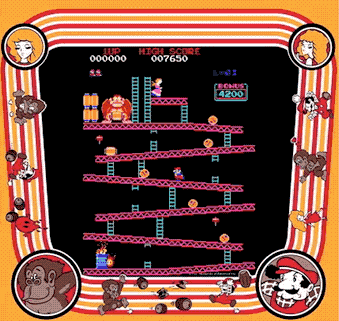


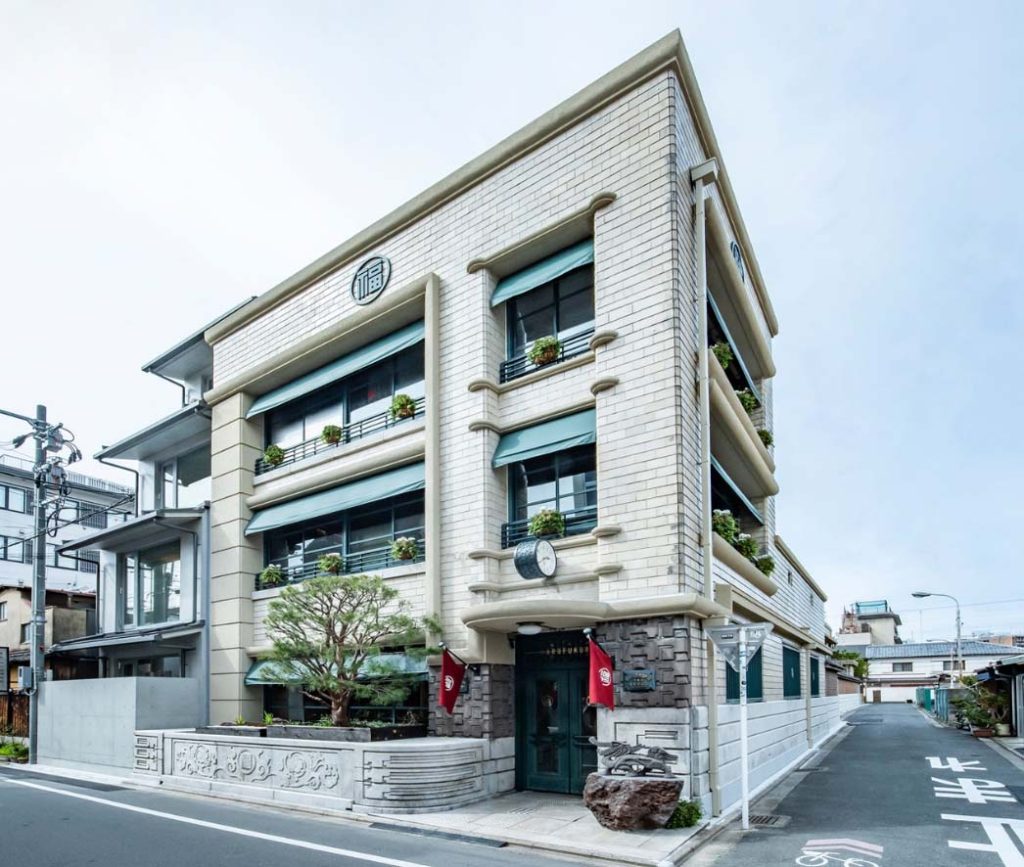




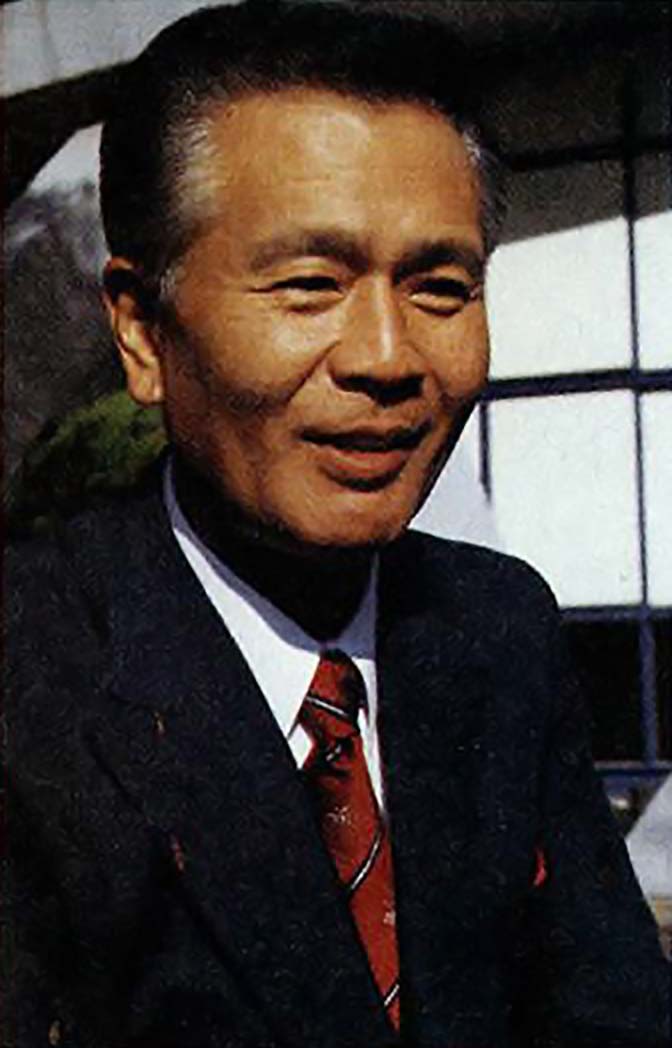


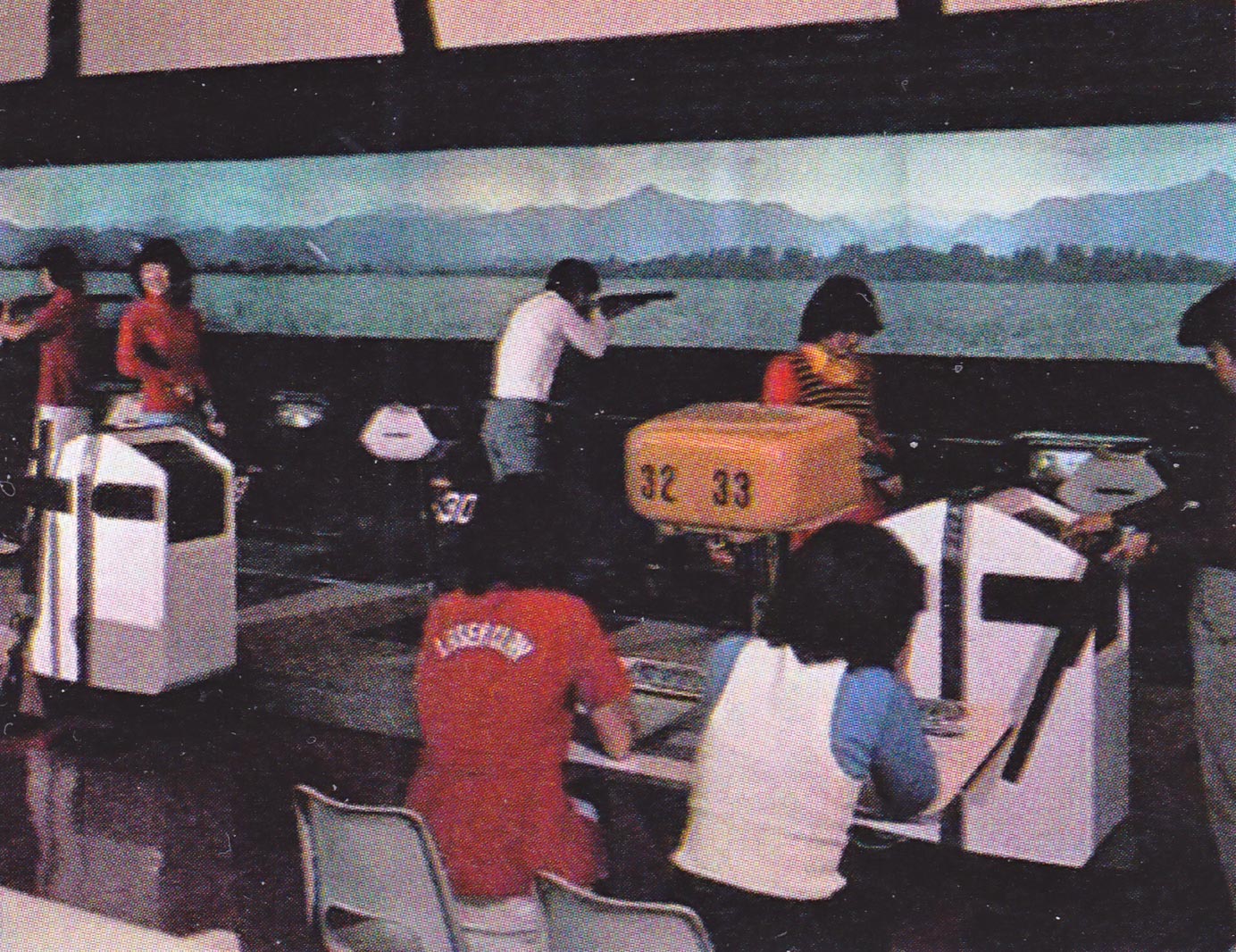
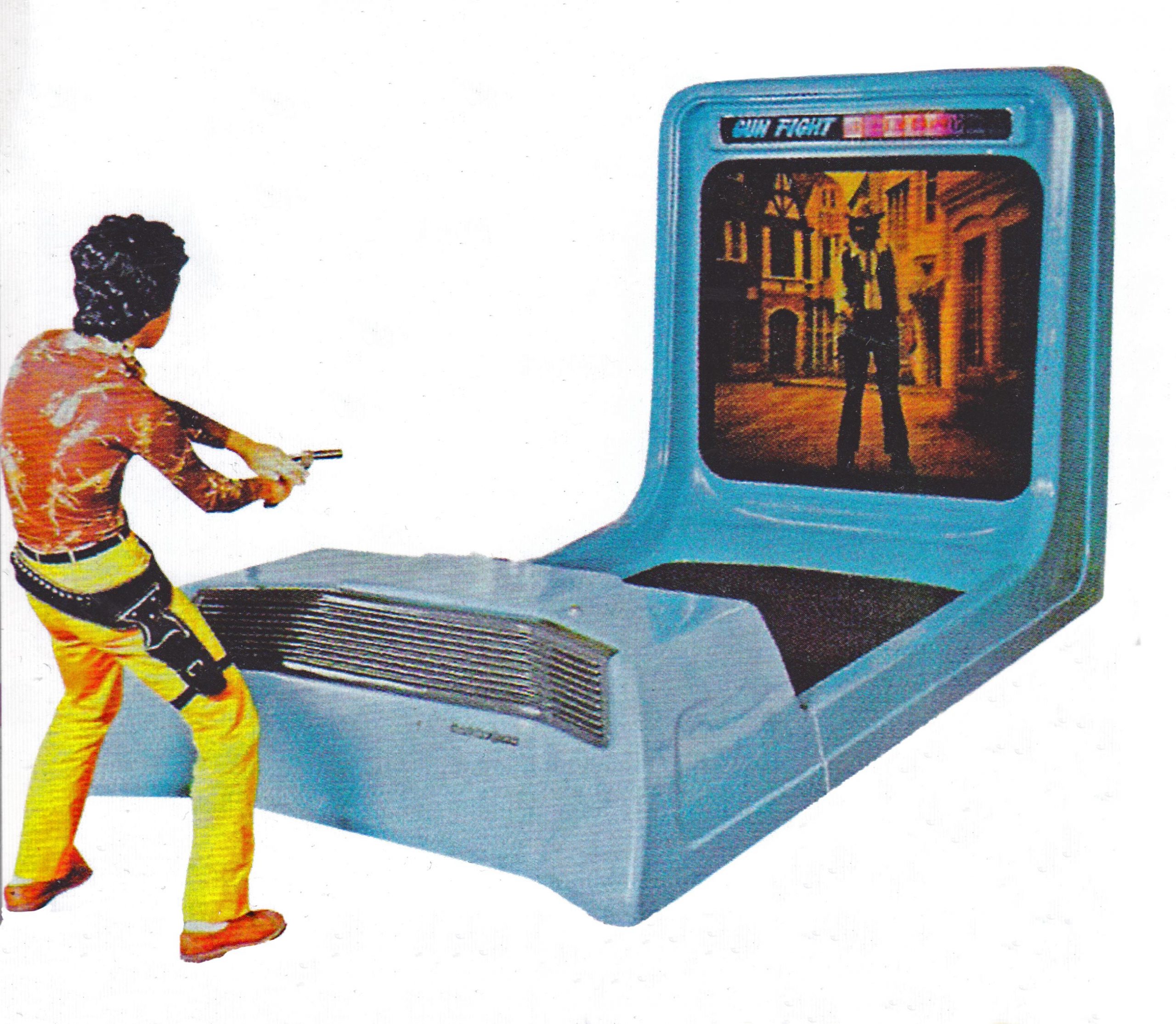






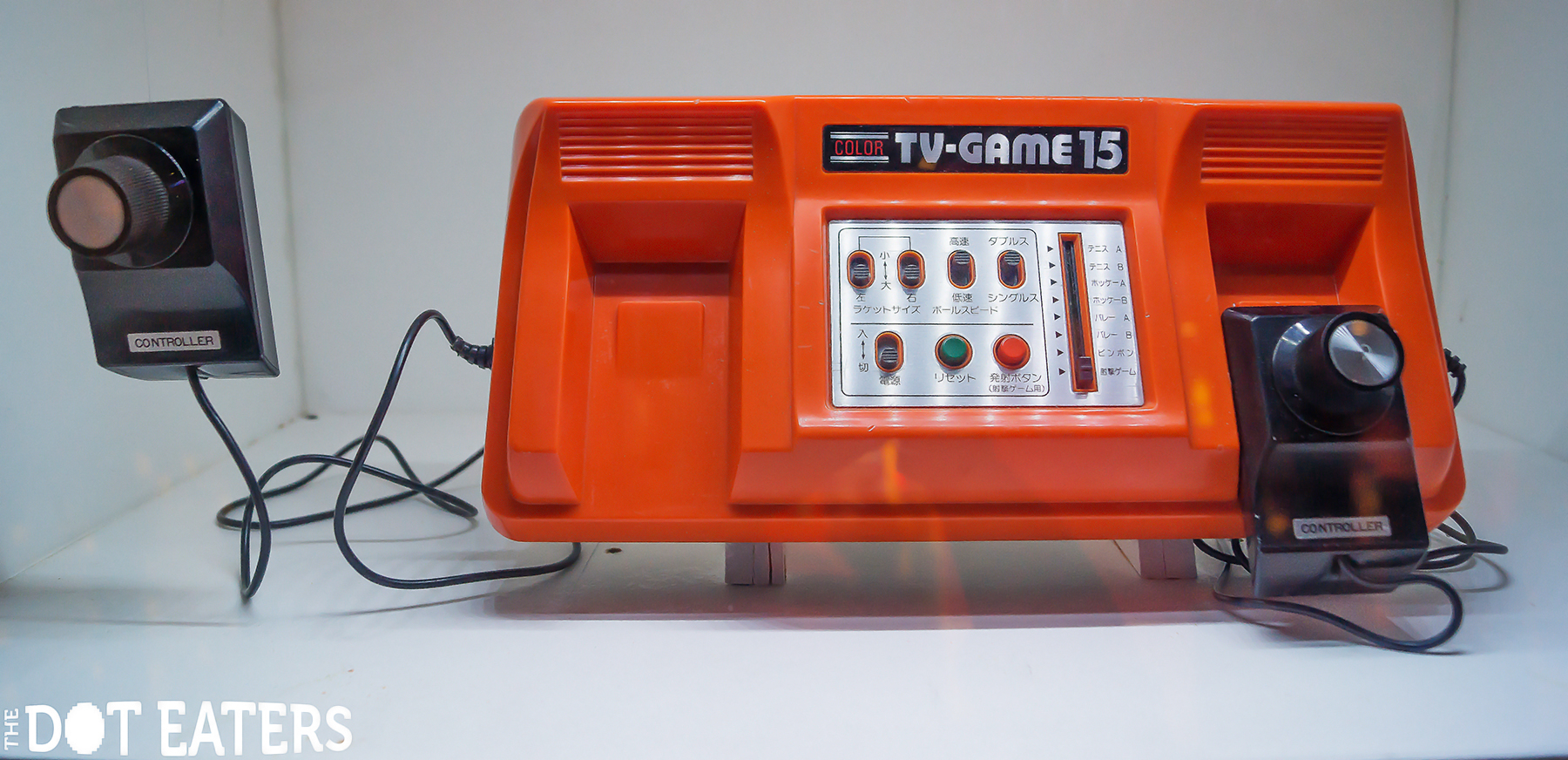














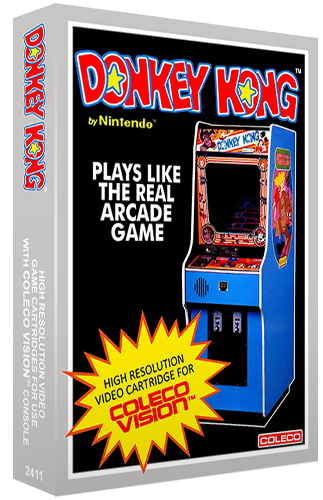

















The TI-99/4A version also had the cement pie level.
Great to note, thanks for that!